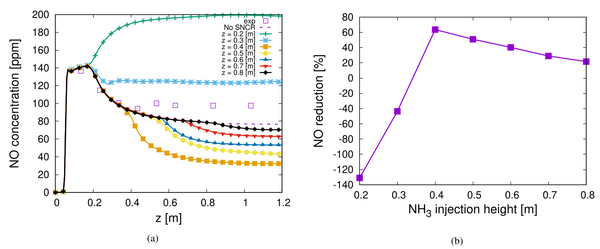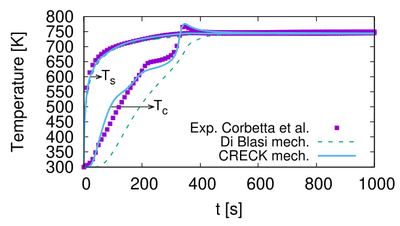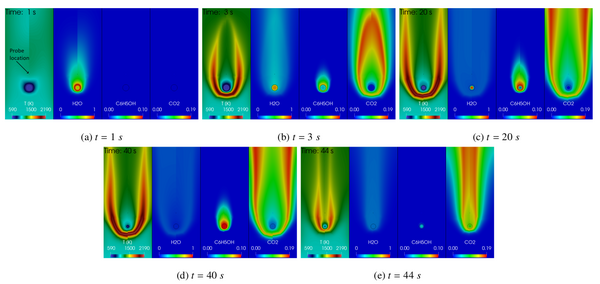Numerical modeling of fixed-bed biomass conversion
Project participants: Seyed Morteza Mousavi, Hesamedin Fatehi, Xue-Song Bai
Background
Biomass is a renewable and CO2-neutral source of energy that is available world-wide and is considered as a promising replacement for the fossil fuels. The solid biomass can be combusted to directly produce energy, or it can be converted to other types of secondary fuels, for instance through pyrolysis or gasification. To reduce the green-house gas emissions, biomass applications have been increasing all across the Europe. Energy from biomass is particularly important in Sweden as it provides more than 25% of the country’s total energy (IEA 2020). However, the biomass utilization suffers from the release of harmful gas species such as NOx or SOx, or the release of ash-forming elements (K, Cl, S …) which are dangerous for the environment and the device itself. Further research on biomass conversion process is still required to improve the efficiency and reduce the emissions of the current technology. Numerical modeling is a strong tool for the studies on this field and can be used to improve the conversion process and the relevant devices.
Numerical modeling of biomass conversion is a big challenge because there is a large variety in biomass sources, it is a multi-phase and multi-scale problem, and there is a high number of various processes to be considered in different technologies. Biomass can be obtained from various sources such as woody/forestry, agricultural, and herbaceous residues. Not only different plants have different structure and constituents, but even in one specific plant such as a tree, the wood properties are highly different from the roots to the tip of the branches. During the conversion of biomass, the transfer of heat and mass and the reactions are happening in all of the solid (porous), liquid, and gas phase at the same time. Furthermore, the time and size scales to be considered in the model are extremely different ranging from the reactions in the micro-pores of a solid particle to the flow in a huge industrial furnace. Therefore, various models are required with focus on each scale and its relevant level of details. Finally, a comprehensive model should contain sub-models for the main stages of biomass particles, i.e., heat-up, drying, pyrolysis, and char gasification/oxidation. Depending on the purpose of the study, other sub-models such as particle shrinkage, nitrogen release, K/Cl/S release, gas phase reactions of N or K/Cl/S species, soot release, and ash deposition might also be required. Using the developed models, the overall performance of the device as well as the products and emissions can be studied and the models can be used to improve the current technology of the biomass conversion devices.
Goals of this research project
The main objectives of this project are to develop models to study the conversion of biomass particles in the fixed bed reactors at different scales and with specific focus:
- Detailed 2D/3D single particle model that includes sub-models for heat transfer, drying, pyrolysis, char gasification/oxidation, and shrinkage.
- Fast solving fixed-bed model that uses the pre-processed particle data to accurately model the processes inside the bed.
- Developing sub-models for the release of alkali metals and other ash forming elements (such as S or Cl) from biomass particles.
- Modeling the freeboard with specific focus on NO and K/Cl/S release. Depending on the reactor type, the freeboard can be modeled in Eulerian-Lagrangian (e.g. entrained flow reactors) or the Eulerian-Eulerian (fixed-bed reactors) framework.
Sample results
Some results of two different projects are summarized in the following:
In the first project, the gas-phase combustion in the freeboard of a 11 kW, lab-scale fixed-bed reactor is simulated. The objective was to validate the model, study the NO emissions from the reactor, and then study the Selective Non-Catalytic Reduction (SNCR) method for reduction of NO emissions. In the SNCR method, NH3 is injected at a height above the boiler to react and reduce the NO. The injection height and the ammonia flow rate are the two important parameters that control the performance of the method. Figure 1 presents the effects of NH3 injection height on the NO reduction. It can be observed that early NH3 injection (at low z) where the temperature is too high, can lead to further NO emissions. Also very late injection is less effective because the temperature is too low and the NH3 reactions are too slow. The optimum height for this boiler is found to be around 0.4 m from the bottom of the boiler. Further details on the model, validation, NH3 injection and its effectiveness, and the most important reactions are presented in paper [1].

In another project a detailed numerical model based on OpenFOAM platform is developed for single particle biomass conversion and extensively validated against the experimental data from the literature. The model is 3D and multi-region, i.e., it considers the particle region and the surrounding gas phase as two separate regions which are governed by specific governing equations. The pyrolysis and combustion of biomass particles in the size-range of few centimeters are simulated and validated against experiments. For instance, Fig. 2 shows the center and surface temperature of a spherical particle with 25.4 mm diameter during pyrolysis at 743 K. At the end of the conversion, the center temperature becomes higher than the surface temperature due to the exothermic char formation reactions, which is predicted very well by the model. The effects of porosity and anisotropic heat transfer on particle conversion are studied. Finally, a variable solution frequency scheme is proposed for the stiff problem of particle-fluid coupling. Figure 3 compares the results for the combustion of the volatiles surrounding the particle using the normal and the proposed schemes.


Latest publications
- SM Mousavi, Fatehi H, Bai XS. Numerical study of the combustion and application of SNCR for NOx reduction in a lab-scale biomass boiler. Fuel. 2021 Jun 1;293:120154.
- SM Mousavi, Fatehi H, Bai XS. Multi-region modeling of conversion of a thick biomass particle and the surrounding gas phase reactions. Combustion and Flame. 2022 Mar 1;237:111725.
- SM Mousavi, Ossler F, Finney CEA, Bai XS, Fatehi H. Detailed modeling of hydrogen release and particle shrinkage during pyrolysis of inhomogeneous wood. Proceedings of the Combustion Institute. 2022 [Accepted for oral presentation]
- M Yang, J Zhang, S Zhong, T Li, T Løvås, H Fatehi, XS Bai, CFD modeling of biomass combustion and gasification in fluidized bed reactors using a distribution kernel method, Combustion and Flame 236, 111744, 2022
- H Fatehi, W Weng, Z Li, XS Bai, M Aldén, Recent Development in Numerical Simulations and Ex-perimental Studies of Biomass Thermochemical Conversion, Energy & Fuels 35 (9), 6940-6963, 2021.
- H Fatehi, M Costa, XS Bai, Numerical study on K/S/Cl release during devolatilization of pulverized biomass at high temperature, Proceedings of the Combustion Institute 38 (3), 3909-3917, 2021.
- H Fatehi, W Weng, M Costa, Z Li, M Rabaçal, M Aldén, XS Bai, Numerical simulation of ignition mode and ignition delay time of pulverized biomass particles, Combust. Flame 206:400-410, 2019.
- T Qi, T Lei, B Yan, G Chen, Z Li, H Fatehi, Z Wang, XS Bai, Biomass steam gasification in bubbling fluidized bed for higher-H2 syngas: CFD simulation with coarse grain model, International Journal of Hydrogen Energy 44:6448-6460, 2019.
- H Fatehi, FM Schmidt, XS Bai, Gas phase combustion in the vicinity of a biomass particle during devolatilization–Model development and experimental verification, Combustion and Flame 196, 351-363, 2018.
- H Fatehi, ZS Li, XS Bai, M Aldén, Kinetics of alkali metal release during biomass pyrolysis, Pro-ceedings of the Combustion Institute 36 (2017) 2243-2251.
- H Fatehi, XS Bai, Structural evolution of biomass char and its effect on the gasification rate, Applied Energy 185 (2017) 998-1006.
Funding agency
STEM through CECOST
Industrial partners
Kraftringen, Babcock-Wilcox Volund, Danmark
